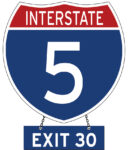 Editor’s Note: This is the 23rd chapter in Volume 2 of Editor Emeritus Donald H. Harrison’s 2022 trilogy, “Schlepping and Schmoozing Along the Interstate 5.” All three books as well as others written by Harrison may be purchased from Amazon.com.
Editor’s Note: This is the 23rd chapter in Volume 2 of Editor Emeritus Donald H. Harrison’s 2022 trilogy, “Schlepping and Schmoozing Along the Interstate 5.” All three books as well as others written by Harrison may be purchased from Amazon.com.
Schlepping and Schmoozing Along the Interstate 5, Exit 30 (Sorrento Valley Road): El Camino Memorial Park
From northbound Interstate 5, take Exit 30 (Sorrento Valley Road) and turn left onto Roselle Street, then right onto Sorrento Valley Boulevard; follow it to a right turn on Sorrento Valley Road; turn right again onto Carroll Canyon Road, and turn left into the Memorial Park at 5600 Carroll Canyon Road.
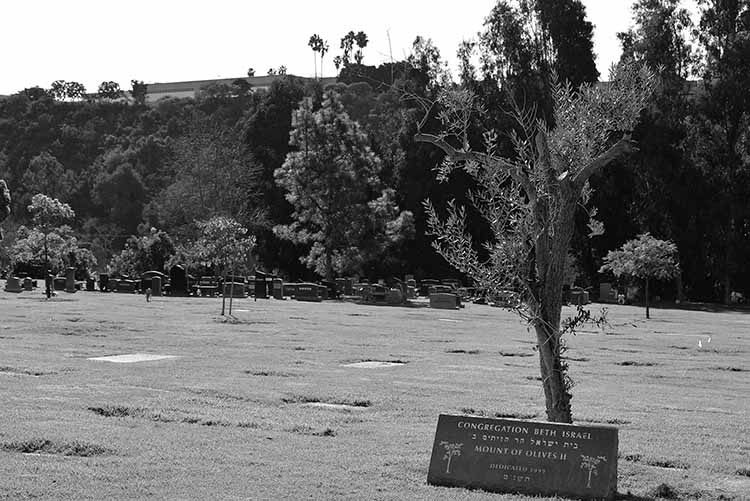
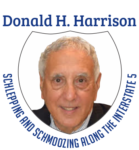 SAN DIEGO – Between the time a Jew utters the Vidui (confessional prayer) on his or her deathbed and is buried in any of seven Jewish areas at El Camino Memorial Park, there is a flurry of activity involving groups of people intent on complying with Jewish rituals for the proper treatment of the deceased.
SAN DIEGO – Between the time a Jew utters the Vidui (confessional prayer) on his or her deathbed and is buried in any of seven Jewish areas at El Camino Memorial Park, there is a flurry of activity involving groups of people intent on complying with Jewish rituals for the proper treatment of the deceased.
These include the rabbi or cantor who will officiate at the funeral; a shomer (watch person) who will recite Psalms in the dead person’s behalf between the time of death and the funeral; members of the Chevra Kadisha (sacred society), who will wash, shroud, and place in a coffin the body of the deceased; the personnel of the mortuary; and the workers at the cemetery itself.
The Vidui
Since he was ordained in 1974, Rabbi Martin S. Lawson, the emeritus spiritual leader of Temple Emanu-El (God is With Us) has been called many times to the death beds of congregants in time for their Vidui. “If a person is still cogent, they can actually say it on their own behalf at that time,” he told me in a February 2022 interview. “Vidui is an actual prayer; it is in the rabbi’s manual and available in home prayer books” as well as on the Internet. “If a person is not able to say it, on his or her behalf, you ask permission, even if they are in a coma, of the person to say it on their behalf and then it is said normally with as many family members who want to be present for it.”
The prayer ends with the Shema [Hear O Israel, Adonai, our God, is One] “because the Shema is supposed to be the last words you speak in your life,” Lawson said. “I can’t tell you how many times I have done that, and I have watched the person ease more readily into their death. As many physicians and scientists say, the last sense that goes is hearing, and if a person is at all cognitive and hears you as it is being said, it eases them into their death.”
Typically, once a patient has expired, Rabbi Lawson calls the Am Israel (People of Israel) Mortuary, the only exclusively Jewish mortuary in San Diego, and arranges for them to pick up and care for the body.
The Mortuary
Larry Krantz, son of Am Israel’s cofounder, the late Irv Krantz, is the second generation of his family to own the mortuary located at 6316 El Cajon Boulevard in San Diego. His son, Peter, and son-in-law, Vince Storniolo, are active in the business, bringing the family’s involvement to three generations. Krantz hopes that, in time, a grandson will be brought into the business as the fourth generation.
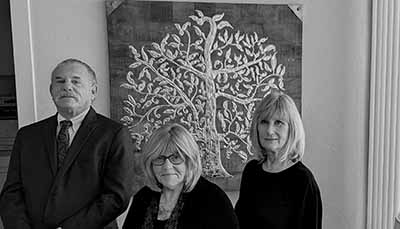
Krantz or his staff begin filling out government-required forms as soon as they learn of the death and inquire of the next of kin what kind of funeral they want. If the family is Orthodox, or traditional, they may request the services of a shomer and the Chevra Kadisha. If they are non-Orthodox, these traditional services might be dispensed with. The mortuary also will contact the cemetery to schedule a funeral, either at graveside or in the chapel with burial to follow.
Irv Krantz and Norbert “Bert” Schloss cofounded Am Israel in 1977, after a friend of Irv’s had passed away, but no Jewish mortuary in San Diego existed to prepare for a Jewish funeral He and Schloss both had been in the insurance business, but they decided to learn the funeral business. With the help of Wally Featheringill, who owned Featheringill Mortuary next door, they set up a separate mortuary.
“It took time; they had to learn the law and the rules, but Mr. Featheringill helped them a lot,” Larry Krantz recalled. “Mr. Featheringill already had a mortuary going, so he knew all that stuff. He held their hand: ‘You need to file for this permit, you need to file for that,’ and he led them, but my dad did the leg work.” Am Israel’s two founders consulted with Rabbi Yonah Fradkin, regional director of Chabad of San Diego County, concerning Orthodox ritual, and with Rabbi Samuel Penner, the late spiritual leader of the now defunct Congregation Beth Tefilah (House of Prayer) concerning the requirements of Conservative Judaism. (Beth Tefilah subsequently merged with Congregation Adat Ami [Congregation of Friends] to form the Ohr Shalom [Light of Peace] Synagogue.)
The biggest difference between a Jewish mortuary and a non-Jewish one, according to Larry Krantz, is the time constraints that typify the schedule of a Jewish mortuary. “Most Jewish funerals are within 24 hours,” he noted. “If someone passed away Tuesday morning, by Wednesday morning they are in the ground. That is the biggest difference. Jews are pretty simple as far as funerals are concerned. Plain pine boxes, no embalming, no viewing, no open casket, and bury as soon as possible – those are the biggest differences.”
Those are coupled with Am Israel’s ongoing arrangements to call in a shomer as needed as well as the Chevra Kadisha.
The Shomer/ Shomeret
Doris Jaffe got her start as a shomeret (feminine version of a shomer, or watch person) in Cleveland, Ohio, in 1876, three years before she and her late husband, Wilbur, moved to San Diego. They were taught the responsibilities of shomrim by the Lubavitcher Chasidic movement, popularly known as Chabad (an acronym made from the Hebrew words for “wisdom, understanding, and knowledge.”)
The task of the shomeret is to stay near the body of the deceased between the time of death and the funeral. By reading Psalms during this period, it is believed that the shomeret comforts the deceased’s soul, which is believed to hover near the body prior to burial. The gender of the deceased is not an issue in the selection of a shomeret. Even for non-halachic Jews (those that don’t follow Orthodox Jewish law) these rituals are available.
“There are 150 Psalms and you are supposed to say all of them” during that period, according to Jaffe. “I don’t always go in order, but I say all of them.” She reads the Psalms in a whisper, typically in a room just outside the area where the body is kept or in one of Am Israel’s offices.
Reciting the psalms “is a very big mitzvah (commandment/ good deed) and you are doing something the deceased can never repay,” said Jaffe. “You are doing something out of the kindness of your heart, and it is helping them. That is basically why I do it.”
Jaffe has some of the 150 Psalms memorized, particularly Numbers 113 through 118 which are said in synagogue on holidays. “Chapter 119 is the longest one,” she said. An acrostic, “there are eight sentences for every letter of the alphabet. I can do that one in 10 minutes. I think I can get them all don in 3 ½ to 4 hours. Sometimes I start with Number 90 which is in Book 4, then Book 5. I usually start with those because I can rattle them off quickly. Then I go back to Book 3, Psalms 73 to 89. There are only 17 of them but they are very long. Those take as long as 107 to the end. Psalm 1 through 41 take me about 40 minutes to say, and 41 through 72, I can get through pretty quickly.”
Asked which Psalms particularly resonate with her, Jaffe responded, “the 23rd Psalm (Yea, though I walk through the Valley of Death …”) which we use for everything. Also 121, 130, 141, and 142.”
The Chevra Kadisha
Karen Bloch is a member of a group of women who serve as a Chevra Kadisha for female Jews whose bodies will be ceremonially washed, shrouded, put in a coffin, and prayed over at some point in the interim between death and burial. A similar group of men will perform these tasks for male Jews. If instruction is needed on a point of halacha (Jewish law), the Chevra Kadisha will consult with Rabbi Moishe Leider of Chabad of University City or Rabbi Avram Bogopulsky of Beth Jacob Congregation.
The ceremony of washing, shrouding, and casketing the body is known as tahara (purity). At all times, Bloch said, the deceased is shown utmost respect.
“We make sure that we are appropriately dressed,” Bloch said. “That means you wouldn’t show up in your sweats. We wear a skirt and blouse, we cover our hair, we are garbed with a gown and gloves. The idea is that you treat the meitah (female dead person) with respect. We treat her as though she were among us.”
For example, “We don’t lean across people when they are alive, and we treat them gently and modestly, with respect and with lots of love and kindness. That is what it is about: helping someone get dressed for their last journey.”
“When we come in, we light a yahrzeit (memorial) candle and we introduce ourselves to her. I will say, ‘I am Karen’ – I will use my Hebrew name – ‘and I have come to do your tahara. I apologize for any inconvenience I may cause you. I want you to be comfortable.’ I say that quietly, and each one of us (in a team of three) will do that. Then we start; she is covered with a sheet” with a cloth placed over her eyes.
The members of the Chevra Kadisha say a prayer for forgiveness, that the deceased might “tread righteously in the Garden of Eden,” Block said. The sheet is unfolded a little bit at a time, exposing only that section of the body which is being washed as the women continue to intone the prayers.
After the washing is completed, the deceased woman is briefly uncovered, so that water may be poured over her body – the equivalent to immersing her in a mikvah (ceremonial bath).
One woman stands at the head; the other women stand on either side of the body. “We start at the top of the head, and we gently pour water, all very natural, very organic, no scrubbing. We will do her left side and then her right side follows, and then we will do her back.”
After the water is poured over her, “we are very quick to cover her and then we will dry her off with a towel,” Bloch continued. “When she is completely dry, we will recite from Isaiah and Zechariah (Biblical prophets) all about beautiful clothes and we will dress her in a very specific order. The garments consist of a pair of long pants that are closed at the bottom. Those will be the first to go on. Then there is an undershirt which is basically a collarless tunic that goes over her head, and then a tunic with a collar that goes after that. They get tied with special knots. Everything should come undone with one tug. There is also a belt, which gets tied with three slip knots. When tied it looks like a shin,” a Hebrew letter used as an initial for one of God’s names, Shaddai (Almighty.) Men (and more recently women) praying with tefillin (phylacteries) place the straps on their right hands in the same configuration.
Additional items of the shroud are a veil and a bonnet. Earth from the Mount of Olives are placed in the bonnet and over the woman’s heart and genitals. (As we’ve seen in the earlier chapter on Mount Olivet Cemetery in Volume I, there is a traditional belief that when Mashiach [the Messiah] raises bodies from the dead, the process will begin at the Mount of Olives.)
“After she is nicely dressed, we will place her in the casket,” said Bloch. “We have a hoist. The casket is a pine coffin with a hole in the bottom so that the earth can come through. We put sand over her eyes and mouth and a piece of pottery on her eyes and mouth to help her look inward, not outward. What we do then is wind a sheet around her. We start from the left, feet, right side, and the head. The sheet is in a diamond shape. Then we cover the casket. There are more prayers, and then we ask for forgiveness in the name of the Chevra Kadisha, telling her that we did everything in her honor. I will say my name again, asking for forgiveness in the name of my mother for anything I may have done to offend or inconvenience her.”
The process averages about two hours, Bloch said. She confided that after losing her first child, a week after he was born in South Africa with a heart problem, “I had no idea what happened to him” after they were separated. “They just tell you that he was buried.” In 1995, when a woman belonging to a Chevra Kadisha invited her to participate, Bloch felt that would be a good way to resolve “the nagging question of what had happened.”
“When I got there the next morning, it was completely natural and it came easy to me,” Bloch said. “I was reassured because I felt as if my child were treated with such kindness and care.”
Even after 27 years of service in the Chevra Kadisha, Bloch told me in January 2022, “I never leave without being grateful that I am alive and that I am here to do these things.”
The Rabbi
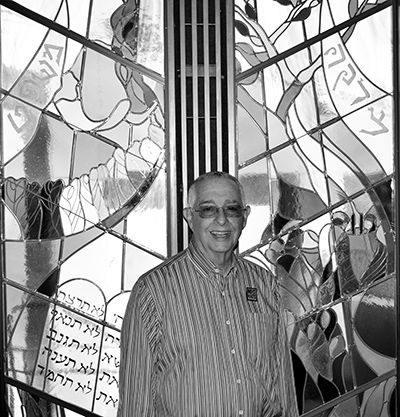
Between the time of a person’s death and the funeral, Rabbi Lawson will meet for an hour and a half, or sometimes two ours, to get a sense of who the deceased was, “what their values were, what gave them joy, what gave them sorrow, what challenged them – all those different things I ask while preparing for the eulogy.”
Lawson’s litany of questions for the mourning family ascertaining or establishing a Hebrew name for the deceased and his or her parents. “Then we will seek information about when and where they were born, how large was their family while they were growing up, where did they grow up, what was the background of their parents. We talk about schooling and the things that the person developed as they grew older — sports, extracurricular activities, and things like that. If they were married, when and where did they meet their spouse? What kind of relationship did they have? One of the things that people have told me is that this process of sitting together and gathering information for the eulogy will very frequently be a time for the kids or the grandkids to learn things that had never been talked about in the family before. It is really an amazing thing. It was kind of a given that these things were known, but they weren’t. And many said, ‘Wow, that was amazing! I didn’t know that about him or her.’ That is one of the very lovely things about this.”
The rabbi tries to have the funeral scheduled as soon as possible, within the customary 24-hour period if feasible. “But very frequently, they won’t or can’t,” Lawson said. “They have someone coming from Israel; they have someone coming from the East Coast. Especially with COVID and everything going on, there is something that has changed, radically changed: We livestream the funeral service. They have the facility now to set up a camera and livestream it for people who cannot get there because of COVID or for whatever reason. We are doing that, I would say, 95 percent of the time.
Rabbi Lawson will ask the family whether they want the service to be held graveside or in the chapel. On rare occasions, it is held in the synagogue. Do they want pallbearers to carry the coffin from the hearse to the grave? Or would they prefer to have the casket already sitting above the grave on the carrier? If they choose to have the casket carried from the hearse, there is a tradition that the pallbearers will recite psalms along the way sand stop along the route. In some traditions, they will make seven stops; in others, they will make three.
“I explain the tradition of kriyah, the tearing of the garment or the ribbon, and explain the significance of that. Going back to biblical times, when you heard of a death or witnessed the death of a loved one, you tore your clothing. In Orthodoxy, they still do it, and some Conservative Jews still do it. Very rarely does a Reform Jew cut their tie or their jacket or their dress, but in Orthodoxy it is still done to this day. The ribbon became a replacement for that. I explain to them how the ribbon is placed over the heart only for a parent. For all other relatives, it is placed on the opposite side, according to a rabbinic tradition. There is no actual explanation for that I know of – I guess it is because of holding a parent higher than any other relative.”
Ribbons are given to the mourning family at the gravesite. They are torn just before the service begins, while reciting in Hebrew, “Blessed are You, the Judge of truth.” The ribbons are easy to tear, but just in case Lawson carries a little knife with which he can nick the ribbon. “One of my colleagues explained in a beautiful way that the sound of the ribbon tearing is the sound of loss – it gives physicality to the loss,” the rabbi said.
“The casket is lowered to ground level so that the top of the casket is right at the top of the grave,” Lawson said. “The tradition here, the rabbinic tradition, is that death is the equalizer; death levels us all.”
Preliminaries over, the funeral service begins with reading of Psalms, including the 23rd and 121st Psalm. “It is pro forma in many ways, for a woman, if she is married and had children, we will recite Eshet Chayil (a woman of valor) but not everyone uses it. In the rabbi’s manual, there are some funeral prayers, some contemporary ones, and some more traditional ones. Then the eulogy or eulogies are given.”
In previous times, the eulogy or hesped was delivered only by the officiant. In some cases, the person wrote out what he or she wanted said at the funeral and may even have included an ethical will to be read at that time. “Sometimes,” the rabbi noted, “family members will want to speak. That is becoming more and more of a trend. In today’s world, many people –children, grandchildren, the spouse even – will want to step forward and make brief remarks during the service. I give them some parameters in terms of time because some people will get up there and if they are not given a limit will go on and on. So, normally, I ask them to type it up, so if they get emotional that will be an anchor for them, and to make it fairly concise. In some cases, I will do my eulogy firs, and in other cases, I will follow the family.”
On occasion, no one knows the deceased well enough to talk about him or her. Perhaps what they do know about the deceased, they would prefer not to speak about, in accordance with the mandate: “Don’t speak ill of the dead.” In such an instance, said Rabbi Lawson, it is appropriate to use the occasion to “talk about the nature of life and death.”
Following the eulogies, Lawson continued, “there is a communal prayer where we’re going to lower the casket the rest of the way unto the grave. In the tradition, these prayers are known as tziduk hadin (righteousness of judgment). These are the prayers, established by the rabbis, that say ‘whoa re we to question God? We are not in control. We like to think we are, but we are not.’ Some rabbis today don’t say it because they are uncomfortable with the theology behind it. I tend to select parts of it that make sense to me and still acknowledge that we are not in chare of our lives, that god plays a major part.
“At the end of that is a prayer most people know from davening (reciting prayers in synagogue), the second paragraph of the Amidah (prayer said while standing): ‘You are might forever God; You bring life, and You bring death,’” Rabbi Lawson continued. “That prayer is recited as the casket is lowered into the grave. Normally, we ask everyone who is able to, to stand out of respect for the deceased. So, we lower the casket and usually it is the cemetery workers who do that. They remove the straps, and they will uncover the mound of earth at the gravesite.”
Next, in a non-Orthodox service, family and friend will chant El Moleh Rachamim (God full of Compassion). Orthodoxy will wait to chant that prayer as well as the Kaddish (special prayer praising God) until the entire grave is filled in. El Moleh Rachamim asks “the Gold of Compassion to bring the person’s soul into God’s care,” Lawson said. “It actually mentions the Garden of Eden and that the person dwells with God through eternity. That is when we use the person’s Hebrew name. Normally we translate it into English because many people do not understand Hebrew. Following that, we recite Kaddish. I hasten to point out that the Kaddish makes no mention of death. There are nine different forms of Kaddish in rabbinic tradition; the one we use is called Kaddish Yatom (The Orphan’s Kaddish). This was the one that was recited by an orphan at gravesite for his father; it became the Mourner’s Kaddish.”
Years ago, he said, the only people who recited Kaddish were members of the immediate family: children, spouses, siblings, and parents. Ten years after the Holocaust, however, the Central Conference of American Rabbis decided that “with so many left with no one to say Kaddish for them, we ask for everyone to rise for Kaddish who is able to do so.”
The custom of chesed shel emet (loving kindness of truth) involves the mourners, relatives, and friends covering the casket with earth, according to an Ashkenazic (Central European) tradition.
“We normally do three shovels full of earth,” the rabbi said. “For the first one, under Ashkenazic tradition, it is the custom to take the first shovel and turn it upside down and scoop up some earth with the shovel reversed. You are doing this mitzvah but you are doing it reluctantly. Then you can reverse the shovel and do it normally. Some people don’t use the shovel at all; they use their hands. That is perfectly acceptable. That is where we get the tradition, I think – there is nothing written about this – of washing hands when you return from a funeral. There also was a pretty common belief that somehow death would taint you. If you were Orthodox, if you were a Kohain (member of the priestly family), you could not enter a cemetery. That is biblical. Rabbis went into mikvah (ceremonial bath) in order to purify themselves so they could then go into minyan (a quorum for prayer.)”
“After the immediate family, who are the mourners, perform this mitzvah, we invite anyone present at the funeral if they wish to,” Lawson said. “For me, Jews, non-Jews, it doesn’t matter; men, women, children, whoever want to do this. If I have somebody who is physically disabled including an immediate mourner, what I will do is take a shovel full of earth, and I will bring it over to them and let them touch that earth and then place it on their behalf on the grave just so they can perform that mitzvah.”
In Reform and Conservative movements, cemetery workers complete the task of filling in the grave usually after the family has left, whereas in Orthodoxy, the mourners and their supporters will do so. Lawson said that when the service is done, “People form two columns through which the mourners walk back to where their cars are parked.” The ceremony invokes the time of the Temple in Jerusalem when people in mourning made a circuit around the temple Mount on a path paralleling one used by other people, Lawson explained. When the non-mourners pass by those in mourning, they say the following to them: “May God comfort you among the mourners of Zion and Jerusalem.”
The Cemetery
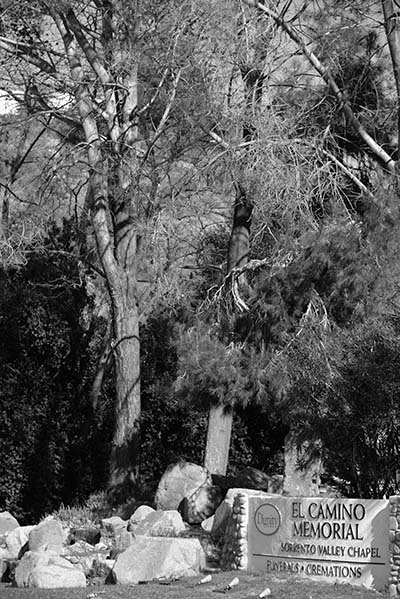
El Camino Memorial Park at 5600 Carroll Canyon Road was founded in 1960 on 220 acres in the Sorrento Valley. Today, according to Doug Trobaugh, its general manager, approximately half that acreage is in use with another 60 acres being held in reserve. The rest, because of topography, is not developable. The cemetery has lawns for many different religions, including seven reserved for Jewish burials. They have such names as Garden of Eden, Mt. Shalom Jewish Community, Vista del Sol, and Mt. Sinai I, Mt. Sinai II, and Mt. Sinai III. The plots of the Mt. Sinai lawns are owned by Chabad, which offers them for resale.
Trobaugh said when a lawn is to be consecrated for exclusive Jewish use, he has trees planted at the corners of the property. Thereafter, he said, rabbis and congregants in procession will walk along the borders of the lawn intoning appropriate prayers in a ceremony that lasts approximately an hour.
Most of the time, he said, El Camino (Spanish for “The Way”) will learn of a Jewish death through Am Israel Mortuary, with which it works closely. Trobaugh’s staff will verify that the deceased has purchased a gravesite either through Chabad or his organization, which is owned by Service Corporation International/ Dignity Memorial. If that hasn’t been done, staff will meet with the family to select a property and to sign the appropriate documents. Most Jewish families will order a concrete liner with a hole at its bottom, corresponding with the hole at the bottom of the pine coffin, to allow the body to be exposed to the earth. “This is the idea of going back to the earth,” explained the general manager.
After digging the grave for the funeral, the mound of dirt is left in place and covered with a tarp, so that it will be available for the burial ceremony described by Rabbi Lawson. For other faiths, the soil is taken away in a trailer and not returned until after the funeral.
A crew stands by during the funeral, waiting for the rabbi’s orders to lower the casket to the first position, and later to the second position. They also will remove the tarp from the mound of earth and make certain at least two shovels are available for mourners, relatives, and friends to participate in the burial.
Am Israel Mortuary also has representative son hand. They pass out memorial flyers containing the name of the deceased, along with the dates of birth and death and the wording of the 23rd Psalm. Additionally, the mortuary brings a guest book for attendees to sign as well as the kriyah ribbons and a shiva (seven-day mourning period) candle for the family to light when they return home.
Trobaugh said it is easier on the bereaved family if funeral arrangements are made by people well in advance of their deaths. “The responsibility of selecting the property, paying for it, is taken off the children: they made the choice themselves. There is also savings that comes with that. You are buying something today, but not using it for 10, 20, or 30 years. If you bought your funeral and property 20 years ago, it has doubled if not tripled in value.”
The chapel at El Camino Memorial Park has undergone renovations. Seating about 170 peole, it looks out on a garden at one side. At the front is a large 110-inch screen permitting people to show photographs or videos of the deceased at a funeral or a celebration-of-life ceremony. There also is a grand piano with player piano capability.
Although El Camino has its own mortuary, “if someone is very religious, they won’t be coming through our mortuary because there are some traditions that we cannot help them with,” Trobaugh commented. “I don’t have someone on staff who is Jewish, so I have to get someone from outside. Larry (Krantz) has Jewish employees; so, he can do it in-house. I say, ‘You really need to see Larry.’ With Gentiles, I’m set.”
*
Donald H. Harrison is editor emeritus of San Diego Jewish World. He may be contacted via donald.harrison@sdjewishworld.com